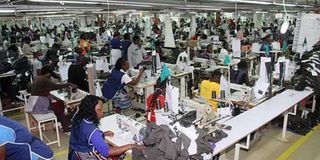EPZ firms barred from selling products in local market

Workers at an EPZ factory in Baba Dogo, Nairobi. The government has silently stopped companies in the Export Processing Zones from selling their products in the local market. PHOTO | MARTIN MUKANGU | NATION MEDIA GROUP
What you need to know:
- The decision to bar EPZ products from the local market is a bizarre twist of events.
- President Uhuru Kenyatta had last year promised to increase their local quota from 20 to 40 percent.
- This was intended to restore the dignity of Kenyans, a majority of whom depend on second-hand clothes
A noble effort to ensure Kenyans stop wearing mitumba clothes has come to a cropper after the government silently stopped companies in the Export Processing Zones (EPZs) from selling their products in the local market.
After only two years of Kenyans flocking KICC and other centres to buy new top fashion brands like Victoria's Secret, Tommy Hilfiger and Calvin Klein at affordable prices, they are now back to mitumba with the halting of the EPZ ‘super sales’.
The decision to bar EPZ products from the local market is a bizarre twist of events considering that President Uhuru Kenyatta had last year promised to increase their local quota from 20 to 40 percent primarily to restore the dignity of Kenyans, a majority of whom depend on second-hand clothes.
DEMEANING
In doing so, the President argued it was demeaning for Kenyans to export new clothes yet they end up wearing the same clothes as mitumba.
The waiver to allow EPZ companies to sell up to 20 per cent of their products in the domestic market duty free and value added tax (VAT) free to promote consumption of locally manufactured apparel had been introduced in 2016 and was riding on the ‘Buy Kenya, Build Kenya’ mantra.
However, a vicious battle in the local textile and apparels industry pitting EPZ companies, local manufacturers, importers and designers has forced the government to backtrack on selling EPZ products locally.
Although companies operating within the zones are still allowed 20 per cent quota for the local market, the decision to introduce a 25 per cent duty on locally sold products has forced them to give the local market a wide berth.
VAT
This is despite the fact that EPZ products are still exempted from 16 per cent VAT. “The government has stopped the sale of EPZ products in the local market,” said Ms Betty Maina, Industrialisation Principal Secretary.
She attributed the decision to the lack of demand yet during the 2016 and 2017 EPZ 'super sales' at KICC, about half a million Kenyans turned up to buy new top brands sold at between Sh100 and Sh600 for items that cost Sh4,000 to Sh8,000 in international markets.
Between December 2016 and March 2017, EPZ companies managed to sell clothes worth Sh40 million and the government had set a target of Sh8 billion annually.
LOCAL MANUFACTURERS
The Nation has learnt the decision to bar EPZ companies from the local market was prompted by wars waged against the EPZ products by local manufacturers and importers who felt threatened.
Local manufacturers, who have been crippled by lack of cheap raw materials, taxes and high costs of production particularly energy and labour, felt allowing EPZ products in the local market would kill the few of them still in operation.
With the cotton industry on its knees, manufacturers largely depend on imported fabric that attracts 25 per cent duty and must also pay VAT.
LOCAL COMPANIES
“The government needs to create opportunities for local companies and this should not be the reason they are shutting down,” said Mr Dominic Ngugi, Thika Cloth Mills Spinning manager.
Importers, who have flooded the market with finished goods from countries like China, Turkey and Dubai among others, also felt threatened by being forced to compete with EPZ products.
The government is targeting Sh100 billion in exports over the next five years.
“We need to expand cotton production to stop the import of fabric,” said Ms Maina.
She added that the government has mapped out 200,000 hectares across 20 counties targeting to increase cotton production from less than 4,000 metric tonnes currently to 50,000 metric tonnes annually.




